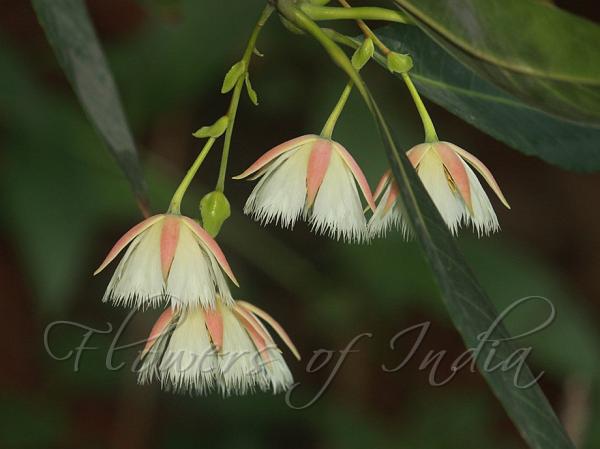|
| Lily of the Valley Tree |
|

|

| File size | 124833 |
| Original date | 4/21/19 7:20 AM |
| Resolution | 920 x 690 |
| Flash | Flash fired |
| Focal length | 90.0mm |
| Exposure time | 1/80s |
| Aperture | 6.3 |
| Focus Distance | |
| Metering Mode | Multi-segment |
| Camera make | Canon |
| Camera model | Canon EOS 700D |
| Sensor type |
|
|
|
|
Photo: |
Botanical name: Elaeocarpus grandiflorus Family: Elaeocarpaceae (Rudraksh family)
Synonyms: Elaeocarpus lanceolatus, Monocera grandiflora, Perinka grandiflora
Synonyms: Elaeocarpus lanceolatus, Monocera grandiflora, Perinka grandiflora
Lily of the Valley Tree is an evergreen tree more than
15 m tall, which is spectacular in bloom. From the tip of each branch
arise many flowers. The trunk is erect, on the base there is some
buttress roots. Young leaves are reddish, mature leaves green and turn
red before dropping. Leaves are alternate, simple, lanceshaped,
sawtoothed, tapering at tip, and narrow at base. The flowers arise from
the scars of fallen leaves. The flowers are arranged in unbranched
racemes, hang downwards, reddish pink and cup-shaped sepals, and
whitish petals with a fringed edge. Stamens are hairy, ovary ellipsoid,
superior. Fruit is a green, ellipsoid drupe about 3 cm, contains a hard
rough seed with slender spines. Lily of the Valley Tree is native to
Indo-China to Malesia, cultivated widely.
Medicinal uses: The crushed bark is used for
poulticing persistent ulcers.The bark is an ingredient of a traditional
drug for women's diseases. A decoction of the leaves is drunk as a
general tonic and is used in the treatment of bilious afflictions. The
leaves are an ingredient of a traditional drug against syphilis. The
seeds are a common ingredient in many traditional 'jamus'. They are
credited with mild diuretic properties and as such are included in
prescriptions to relieve bladder stones and painful urination in
general.
The crushed bark is used for
poulticing persistent ulcers.The bark is an ingredient of a traditional
drug for women's diseases. A decoction of the leaves is drunk as a
general tonic and is used in the treatment of bilious afflictions. The
leaves are an ingredient of a traditional drug against syphilis. The
seeds are a common ingredient in many traditional 'jamus'. They are
credited with mild diuretic properties and as such are included in
prescriptions to relieve bladder stones and painful urination in
general.
Medicinal uses:
 The crushed bark is used for
poulticing persistent ulcers.The bark is an ingredient of a traditional
drug for women's diseases. A decoction of the leaves is drunk as a
general tonic and is used in the treatment of bilious afflictions. The
leaves are an ingredient of a traditional drug against syphilis. The
seeds are a common ingredient in many traditional 'jamus'. They are
credited with mild diuretic properties and as such are included in
prescriptions to relieve bladder stones and painful urination in
general.
The crushed bark is used for
poulticing persistent ulcers.The bark is an ingredient of a traditional
drug for women's diseases. A decoction of the leaves is drunk as a
general tonic and is used in the treatment of bilious afflictions. The
leaves are an ingredient of a traditional drug against syphilis. The
seeds are a common ingredient in many traditional 'jamus'. They are
credited with mild diuretic properties and as such are included in
prescriptions to relieve bladder stones and painful urination in
general. | Identification credit: Prashant Awale | Photographed in cultivation in Maharashtra. |
• Is this flower misidentified? If yes,